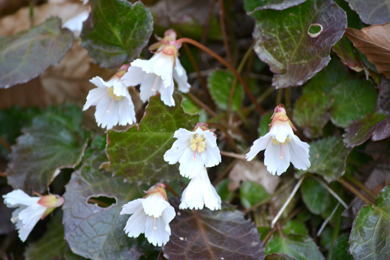a hidden treasure

Don’t miss the blooming
of the rare Oconee Bells
By Olivia Fowler, Courier Staff
A trip to the Jocassee wilderness is more than a journey of a few miles. It’s a passage into another time.
What may be most striking upon arrival is the quiet. There are no motors running, cellphones ringing, people shouting or any other intrusive sounds.
An unpaved road is the only way in, and the terrain is more than a little rough. But anyone worth their salt will not be discouraged. There are about 200 miles of rough logging roads through the woods. There are pine, evergreens and hardwoods.
The beautiful Eastern Hemlock have fallen prey to disease. Their remains are skeletonized reminders of how quickly the natural beauty of the wilderness can be decimated.
The area is only open to vehicles for a few weeks in spring, although travel by horseback or on foot is allowed.
And that is probably the reason the area is so unspoiled.
The Jim Timmerman Reserve in South Carolina consists of 33,000 acres of the Joccassee Gorges in parts of Oconee and Pickens counties. The state acquired the land in 1998, preserving one of the last great existing tracts of wilderness. A portion of the property is in North Carolina.
According to information posted by the S.C. Department of Natural Resources, the property is open during daylight hours year-round, while some roads are open on a seasonal basis. Seasonal access for motorized vehicles is Sept. 15 to Jan. 15 and March 20 to May 10 only. The Horsepasture Road (to Jumping Off Rock) and Camp Adger Road are open year-round for licensed vehicles only. ATVs and other off-road vehicles are prohibited on any road from Jan. 16 to March 19 and May 11 to Sept. 14.
It boggles the mind to realize there was a time when a few hardy souls made this trip with oxen and wagons. They may have paused to eat where visitors of today unwrap ham sandwiches and drink bottled water. There was no great lake in those days, only the rivers. Travelers drank the unspoiled waters then without fear of pollution or any of the other ugly things man has inflicted upon nature. But even though there have been changes, the raw beauty of the place remains.
On a clear day, Lake Jocassee beneath Jumping Off Rock spreads out with peaks of hills rising straight up from it.
Bald eagles have been sighted here, and peregrine falcons nest close by. Gulls who’ve flown up from the Savannah River Basin skim across the tops of whitecaps whipped up by the wind.
There are places in the lake more than 300 feet deep. Beneath the waters are farm houses, barns, fenced pastures and other remnants from the lives of the people who abandoned the valley before the rivers were dammed and the lakes formed during the mid 1970s.
In this place can be found a greater variety of plant species than anywhere else in the world, with the exception of Japan.
On a creek bank nestling in thick layers of fallen leaves are the Oconee Bells. They grow nowhere else in the world but limited areas of the Southern Appalachians.
For centuries, only Native Americans knew of the low-growing plant with its glossy green leaves and delicate bell-shaped flowers. The wildflowers grow in such small numbers and in such remote areas they were a well-kept secret until 1787, when a French botanist stumbled across them and collected a specimen.
André Michaux was sent to America by King Louis XVI in 1785 and spent the next 11 years collecting and cataloguing plant specimens from Florida all the way up to the Hudson Bay. The botanical name for the bells is Shortia galacifolia.
It is believed that when the Spanish explorer Hernando de Soto traveled through the Carolinas in search of treasure in the mid-1500s he did not come through this region, but traveled through what is now Columbia, then into North Carolina and from there Tennessee.
As he and his band of about 600 were accompanied by a herd of swine numbering 300 head, it is certainly understandable why the group didn’t venture through this region.
During the mid 1970s when the area was flooded by the damming of the Whitewater, Toxaway and Thompson rivers, a substantial portion of the wildflowers were destroyed. Naturalists say perhaps as much as 70 percent of the plant population was lost.
Now the Oconee Bell is a federally protected species.
The Bells don’t grow alone. There are dozens of plant species in the region. Some are rare like the Bells. Others are unusual in that they are not native to the area and grow nowhere else in the region. The variety of wildflowers, ferns and moss thriving here is remarkable
Birds seen in the area include the yellow-billed cuckoo, broad-winged hawk, whippoorwill and many different kinds of warblers.
During the next few weeks, while vehicle access is allowed in the area, visitors who appreciate the great diversity exhibited by nature should take advantage of this opportunity.
To visit, drive through Pickens on U.S. Highway 178. Travel north through the intersection of U.S. 178 and S.C. Highway 11. The entrance is on the left and is clearly marked.
Take a picnic, drinking water and a camera and spend a day you won’t soon forget.



























